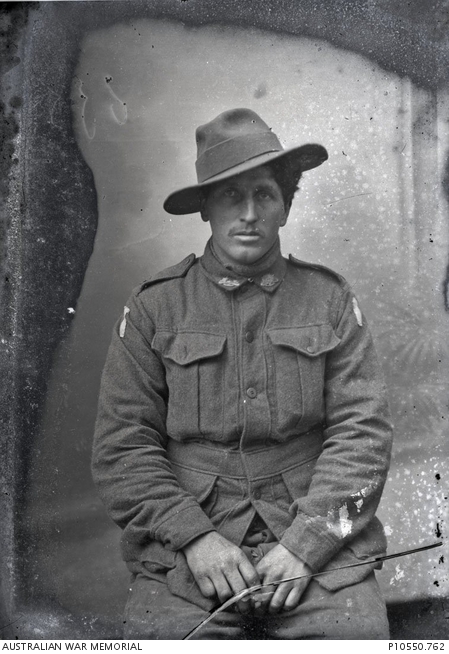'Men who had been in Hell'
The glass-plate negatives from Vignacourt are significant because they offer insights into the reality of life on the Western Front. There are photos that show the laughter and the mateship among these soldiers, and the general feeling of life away from the line. Like any true portrait, many offer an insight into the character and mood of the subject. None of the soldiers in this post have been identified, but photographs created so close to the battlefields of the Somme means portrait subjects who have witnessed true horrors.
Far from the formal portraits taken at studios back in Australia, the expressions in many of these images tell a story very different to the optimism of life at home. Features such as misshapen slouch hats and frayed colour patches suggest that these are men who have truly been ‘in the thick of it’. Other features such as the position of some of their hands together with a particular facial expression hint at war wounds that are beyond the physical.
Now known as Post Traumatic Stress Disorder, the symptoms of ‘shell shock’, the term that emerged during the First World War to refer to the human reaction to trauma, would manifest in different ways. One was the expression on a soldier’s face, described as vacant and doleful. In later conflicts the term ‘Thousand Yard Stare’ emerged to describe this expression, and has come to be understood as the mind’s dissociation from traumatic events.
Sergeant Edgar Rule of the 14th Battalion provided a description of this condition on page 599 of Volume III of the Official History. He had seen the men of the 1st Division pass him on the road after they had been relieved at Pozieres:
‘Those who saw them will never forget it as long as they live. They looked like men who had been in Hell. Almost without exception each man looked drawn and haggard, and so dazed that they appeared to be walking in a dream, and their eyes looked glassy and starey.’
Vignacourt’s proximity to the fighting on the Somme gives this collection of images an honesty that many other photographs don’t possess, and it is this honesty that makes them significant. There are no polished studio portraits here, and no omissions courtesy of the censor’s pen. When viewing the faces of many of these men we can only imagine the horrors that they have witnessed and endured.
Many people have already looked at this collection of photographs on our website.
Look again.
You will always notice something you haven’t noticed before:
/visit/exhibitions/remember-me







